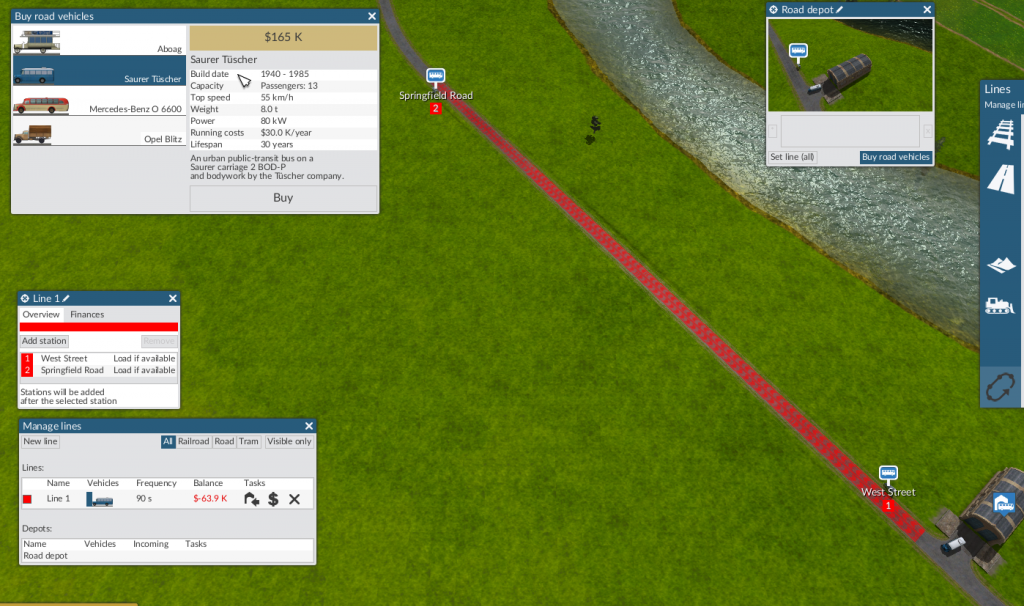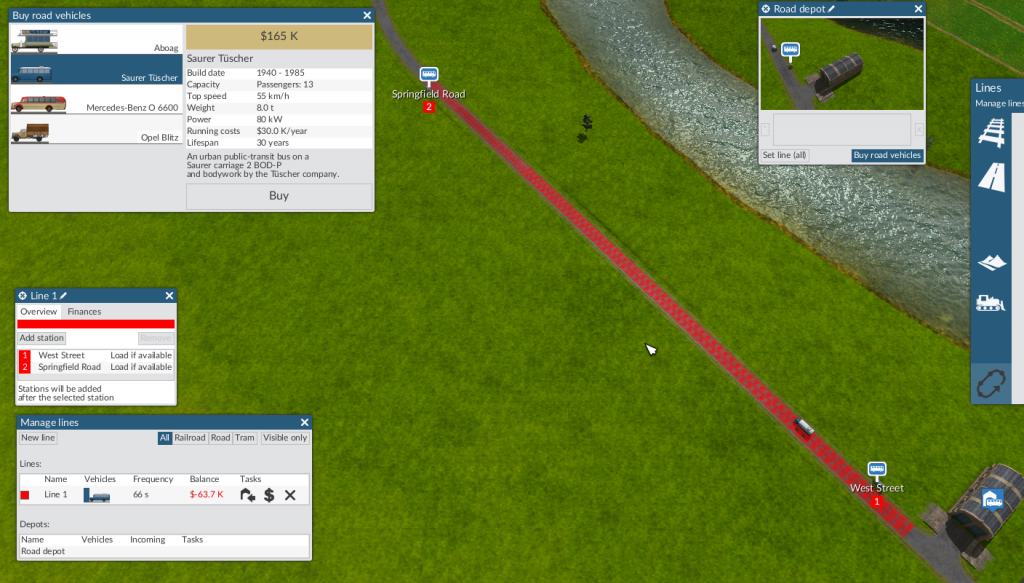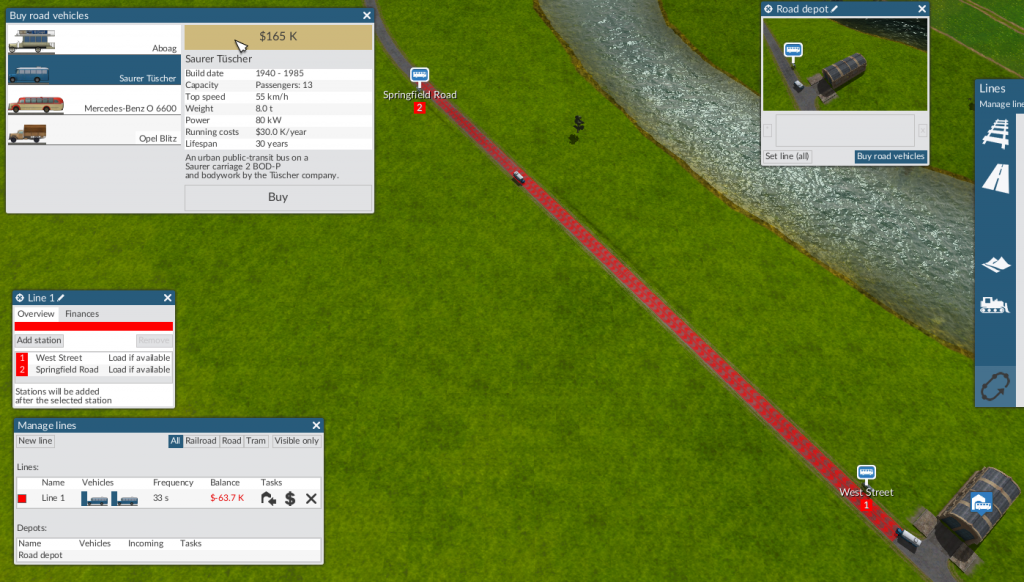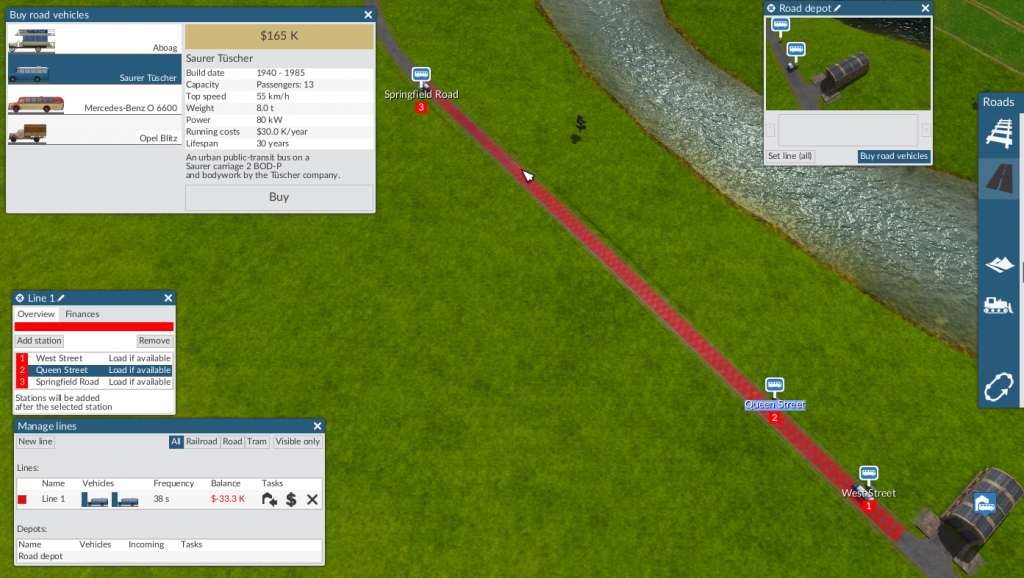Home › Forums › General Discussion › Frequency and the 20 min rule
- This topic has 31 replies, 7 voices, and was last updated 9 years, 4 months ago by
gGeorg.
-
AuthorPosts
-
November 25, 2014 at 14:39 #13772
TrainInfluenza
ParticipantHey all I wonder if someone can confirm if my understanding of frequency is correct.
Travel time from A to B via Bus1, Train and Bus2 is the sum of the 3 frequencies plus the actual time spent travelling in vehicles and walking between stations? i.e. there is no individual ‘waiting time’ – everyone using that line is given the frequency as the same waiting time.
November 25, 2014 at 17:10 #13781gGeorg
ParticipantSum is used for start the route, yes. how ever, the route might finish sooner cose vehicle comes sooner then maximum freq. On the other side, there could be traffic jam. Or a train waiting for traffic lights. in case the agent is late over 20 minutes (it looks to me its 24 actualy) then you dont get paid for the las transport. In your case, you can get money for a bus and train, but second bus could be crowded, the man get over limit so you dont get money for the bus. Pitty is, that in this case man disapear in thin air, popup at home again, but do not travel back.
November 25, 2014 at 21:18 #13788Tossi
ParticipantAs far as I know what Trainfluenza said is true. On the other hand gGeorg you give some false information. The disappearing of passengers is not connected to 20 minute rule. If the hipothetical time travel is higher than 20 mins the agent won’t travel at all, if it is less it will travel to the end even if the actual time travel will be higher than 20 mins.
The disappearing of passengers happens when a building assigned to the agent gets demolished either by player or town growth algorithm.
November 26, 2014 at 00:59 #13792TrainInfluenza
ParticipantI don’t think that’s true Tossi. Have a look at cargo, it keeps disappearing too. It also disappears from the stations as well as the vehicles, just stop any vehicles on a line and watch – cargo doesn’t have a home. You’re right if the sum frequencies of a trip are over 20 they won’t travel at all, but the game doesn’t know how long the trip will take – only the waiting times (frequencies).
I think it works like this…
Walking time + Frequency of Line 1 + Actual trip time on Line 1 + Walking time (This is a one line example you can add more)
If the 20 min limit is busted the person/cargo disappears immediately, walking, waiting or riding – just poof. Some people don’t like this but I do as it’s a good indicator your line is on the limit if it happens a lot.
I haven’t seen the 24 minute example gGeorg but if it works as I suspect then that would explain it, your frequency was say 10min for example but it took a vehicle 14 min to collect the person, due to bunched vehicles on the line or congestion. So the game added only 10 min waiting but you following the person and saw 14 minutes for that waiting part of their travel.
The next interesting question is what order are items/people loaded? First to arrive at station? If you time your line badly all the vehicles will be arriving almost empty.
-
This reply was modified 9 years, 5 months ago by
TrainInfluenza.
November 26, 2014 at 08:55 #13809gGeorg
ParticipantTossi,
my statements are based on observations. Here is an example you could try yourself.
Click a man who waits on train station with long route and low freq. He has a target in other city. Target building should be far from train station, best if reachable by bus. Let him load to train. In the middle of transport, set train stop. This simulates a traffic jam, waiting free path, limited bus line capacity, limited bus stop capacity, … whatever. Wait for 15 minutes then release the train. Train reach the destination, the man leave in destination and suddenly is teleported back home to his original city. No building has changed. After few seconds he pick another target from selection Blue/Red/Yellow and start to travel again.
-
This reply was modified 9 years, 5 months ago by
gGeorg.
November 26, 2014 at 11:08 #13811Norfolk_Chris
ParticipantPerhaps someone from Urban Games could make comment? They must know how this works,
November 26, 2014 at 11:56 #13815TrainInfluenza
ParticipantOne would hope they do 🙂
November 26, 2014 at 12:50 #13820fransgelden
ParticipantThere is a guide about frequency on Steam: http://steamcommunity.com/app/304730/guides/?browsefilter=trend&requiredtags%5B%5D=Gameplay%20Basics#scrollTop=900
I can verify the peeps will vanish if their targeted building or building where they live changes or removed. I cannot comment on the 20 min rule, because I didn’t done an actual observation and waiting 20 minutes.
November 26, 2014 at 12:54 #13821Tossi
ParticipantIf you want the developer comment on the issue of disappearing passengers you can find one in this topic. Also my trains that carry raw resourcers always arrive full at the destination station. Goods do have a destination like passengers do so they disappear when their destination gets destroyed.
November 26, 2014 at 14:48 #13828TrainInfluenza
ParticipantVery interesting thanks for the link @Tossi my assumption was wrong, so are we saying that once a passenger/item journey starts it has to finish no matter how long it takes? Say I stop the train for an hour – providing the origin or destination don’t get demolished in the meantime?
With regard to the frequency guide @fransgelden who wrote that? That person seems a little confused about some core concepts – for example the frequency will be the same at any given station of a line not just the first. If trains leave Berlin for Paris every 15 minutes then they will arrive every 15 minutes and every station in between will have a train pass every 15 minutes no matter what speed they travel, how long the whole journey takes or how spread out the stations are – (assuming a simple line like the game models where the trains don’t wait for other traffic, split or combine etc). From the guide it doesn’t make sense…
Frequency is calculated on the basis of how long something takes to reach the station. This means, if the frequency is 6 minutes, it says your train will take 6 minutes to arrive at the station.
Surely frequency is how often a vehicles passes a station. A particular train could take 6 years to reach a station but if you have enough trains on the line it means some train will pass every station on the line every 6 minutes.
People, including me, become confused by the fact that we got more than 1 station or stop. Bus routes accounts more than 6-10 stops. So how do you know on what station this feature is based on or does it take the average time or is it the travel time itself or what?
I think he’s still confused – frequency is same for every stop – every point on the line infact not just stops. It’s a circle.
Frequency is based on your first stop on the route. The first one you assign in the line. This means it will take ’bout 6 minutes for a train to reach your first station. This also means the train has to finish the whole line before it reach the first station and the frequency is then based from the time it takes to finish the whole line.
Again confusing.
To see the frequency for yourself go to a simple line at the start of a game with about 8 stagecoaches – give them time to space out evenly, then pick a point on the line (any point doesn’t have to be a stop) read off the frequency and count the seconds between the coaches – the number is the same.
But anyway my original question was more to do with how the frequency affects the passengers/items 20 minute timer.
November 26, 2014 at 23:47 #13842fransgelden
ParticipantI know the frequency for the busses has been patched a few weeks ago, because now the value don’t stay constant and changing rapidly. I’ll also going to check it out now if the frequency is based on a single stop or if its based at every stop.
November 27, 2014 at 00:01 #13843fransgelden
Participant@TrainInfluenza: I’ve checked it out and sorry to say, the guy in the guide is somehow right. I started in 1950 with a Saurer Tuser. Then I created a simple circle line with 6 stops. The single bus started to travel and the system said 50 seconds. Then as the bus stopped by every stop, which is 20 seconds apart from each other, the frequency accumulated. There was 6 bus stops and when the bus fully completed the cycle a few times, the new frequency time was around 130 seconds and then changed to 2 min. I also run a timer on my Nokia cell phone and its said every time 137 seconds when the bus fully complete the 6 station cycle. So, the frequency is based on the 1st station on the line and not the average at every station. Otherwise the frequency was supposed to be 20 seconds, because the bus was stopping every 20 seconds at a stop, right?
Make a simple circle loop in the city, around a block with standard roads, no double roads or streets. Put 4 or 6 bus stops and then run 1 bus around it to see the frequency. You will see it starts low, but then builds up as the bus stops by every station.
-
This reply was modified 9 years, 5 months ago by
fransgelden.
-
This reply was modified 9 years, 5 months ago by
fransgelden.
November 27, 2014 at 00:53 #13849crossmr
ParticipantVery interesting thanks for the link @Tossi my assumption was wrong, so are we saying that once a passenger/item journey starts it has to finish no matter how long it takes? Say I stop the train for an hour – providing the origin or destination don’t get demolished in the meantime?
Very interesting thread. 2 1/2 months ago they acknowledge the bug, apparently even from beta and still can’t fix it. Pretty much the story of this game.
November 27, 2014 at 09:33 #13862TrainInfluenza
Participant@fransgelden I did the same test and it works as frequency as I defined it. I said let it settle down. The initial number is a conservative guess, maybe the vehicle speeds are different, maybe the road speed limits are different on different parts of the line, maybe there are inclines. My point is once the number settles after actual measurement (takes about 2-3 laps and probably uses some sort of Kalman filter in the code) it can be timed at any point on the line. If you add a second vehicle the number halves, for a third vehicle a third etc.
1. Takes a 90s guess on first vehicle release

2. Settles on 66s after 2 laps

3. Adding a second vehicle halves the time

4. Adding a stop adds a few seconds

5. Now pick any point on the line, I used the mouse cursor by the tree let a vehicle pass and start a timer, the next one will pass in frequency seconds – 38 in this case. But as I said the line has to settle down and vehicles space out.
My point was if you’re defining frequency in a guide keep it simple – it is how often a vehicle passes any point on the line. The fact that the game takes a few laps to work it out is irrelevant to the player apart from maybe a mention. As I said frequency was never an issue for me – it’s a fairly simple concept for anyone who’s looked at a but timetable. My initial thread question was what the game does with that number in terms of the 20 min rule. Is it just a guide for the initial pathfinding or is that the waiting time for every person on that line.
November 27, 2014 at 09:37 #13863TrainInfluenza
Participant@crossmr I think that’s a bit harsh – the devs have been very active with patches and the game is very stable. A few passengers disappearing is hardly a major issue. It certainly doesn’t keep me up at night and there are half dozen other things I’d like to see addressed first – and I have no doubt they’re working on them.
-
This reply was modified 9 years, 5 months ago by
-
AuthorPosts
- The forum ‘General Discussion’ is closed to new topics and replies.
